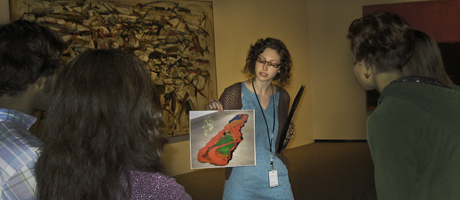By Menachem Wecker
Faye Gleisser, M.A. ’09, enrolled in her first art history course as a freshman at Washington University primarily as a ploy to sidestep a foreign language requirement. Ironically, the field fascinated her so much that she voluntarily enrolled in French and German.
“Art history combines all of my interests in one discipline: politics, psychology, sociology, history, art, creative writing, anthropology and, most importantly, no math!” says Ms. Gleisser, who earned a master’s degree in art history from GW this spring. She has just started a Ph.D. in art history at Northwestern University.
While studying at GW, where she specialized in American and European art of the 1960s and ’70s, Ms. Gleisser worked at the National Gallery of Art as an assistant to the gallery’s lecturers. She performed a wide range of duties, including procuring images, writing newsletters, training docents, maintaining Web sites, designing promotional materials, assembling research biographies, and acting as the departmental photographer and information technology specialist.
Ms. Gleisser, who attended about 100 presentations and gallery talks in her two-and-a-half years at the gallery, says her favorite part of the position was learning from the lecturers. “Public speaking, especially about art, to a non-specialized group is an art in and of itself,” she says. “The lecturers are absolute masters of theatrical timing, diction, poise and intellect. It has been an incredible experience to work so closely with them.”
While attending a feminist theory course at GW, Ms. Gleisser realized the National Gallery did not have any lectures celebrating National Women’s History Month. She suggested to the head of the department that the gallery should offer lectures highlighting women artists in the permanent collection. The department head loved the idea and asked Ms. Gleisser to present a talk of her own from her research at GW. “Of course, I was overjoyed to do so!” she says.
Ms. Gleisser had just completed her graduate seminar paper on Lynda Benglis, an American sculptor with two works on display in the National Gallery of Art’s East Building concourse. The gold leaf, bronze wire and plaster sculptures resemble truncated female torsos and “reflect Benglis’ investment in the body and the subversion of gender,” Ms. Gleisser says. In March 2008, Ms. Gleisser delivered six hour-long gallery talks titled “The Condition of Contradiction: Works by Lynda Benglis,” and in August 2009, she presented a slide lecture, “Duet of Leaf and Stone: Ana Mendieta and Carl Andre” as part of the NGA’s annual summer lecture series.
“I was very nervous at first, but found working directly with the art objects and the public to be a very rewarding and exhilarating experience,” Ms. Gleisser says.
After the Benglis series, Ms. Gleisser developed three additional lecture series: “Art and Nature: Isamu Noguchi’s The Great Rocking of Inner Thinking” in honor of National Asian Pacific American Heritage Month; “Abstract Expressionism, Fame and the Cult of Celebrity” in tribute to the opening of the Newseum; and “Mind and Body: Works by Rachel Whiteread and Lynda Benglis” during National Women’s History Month in 2009.
To Ms. Gleisser, the opportunities at the National Gallery are all part of the experience of being an art history student in the District. “In Washington, there are so many wonderful museums in close proximity, and important and well-connected members of the art world such as conservators, curators and educators often teach classes. You can build a network while still a student,” says Ms. Gleisser, who took a course with curators from the Hirshhorn Museum and Sculpture Garden and the National Portrait Gallery.
Ms. Gleisser also took advantage of curatorial opportunities in Washington. She curated a two-person show at the District of Columbia Art Center, co-curated an exhibit, wrote a catalog essay for an exhibit at GW’s Dimock Gallery, and founded Boiler Gallery, a nonprofit art space where she curated a group show of local artists.
“I’ve found that Washington fosters a nurturing and supportive environment for motivated students,” she says.


